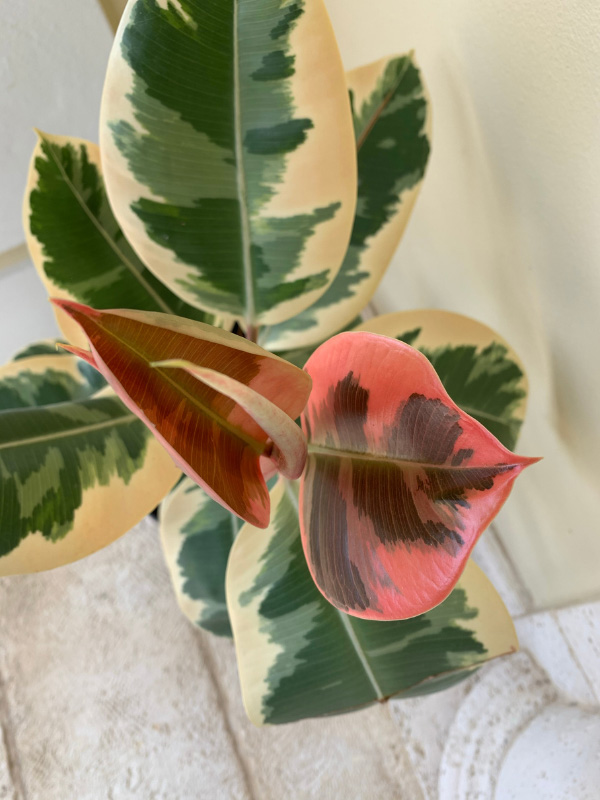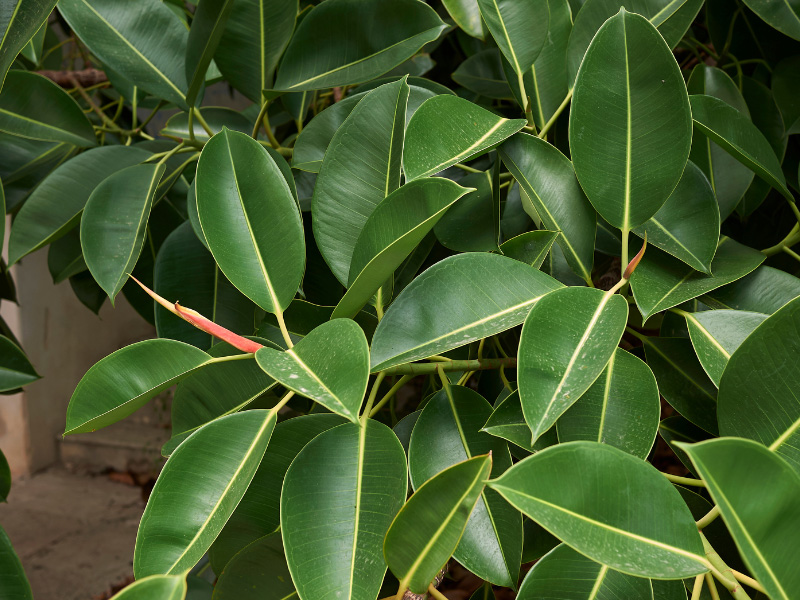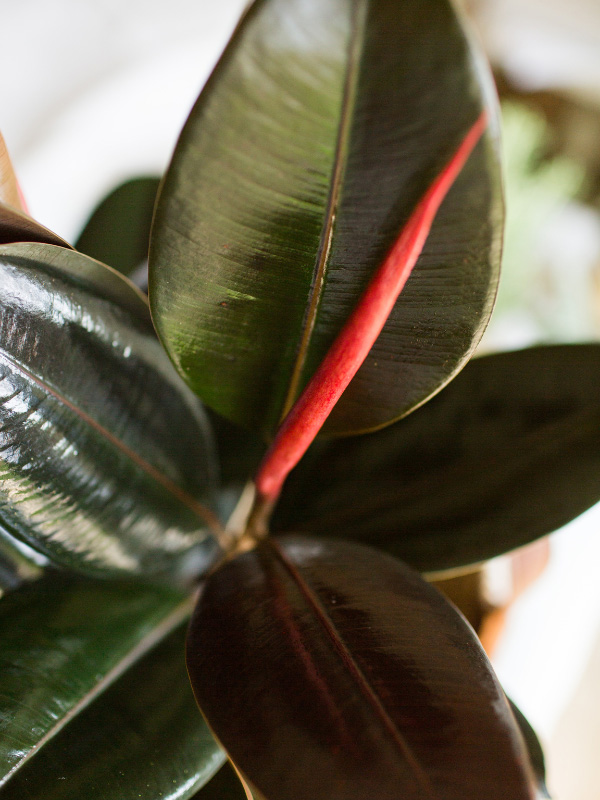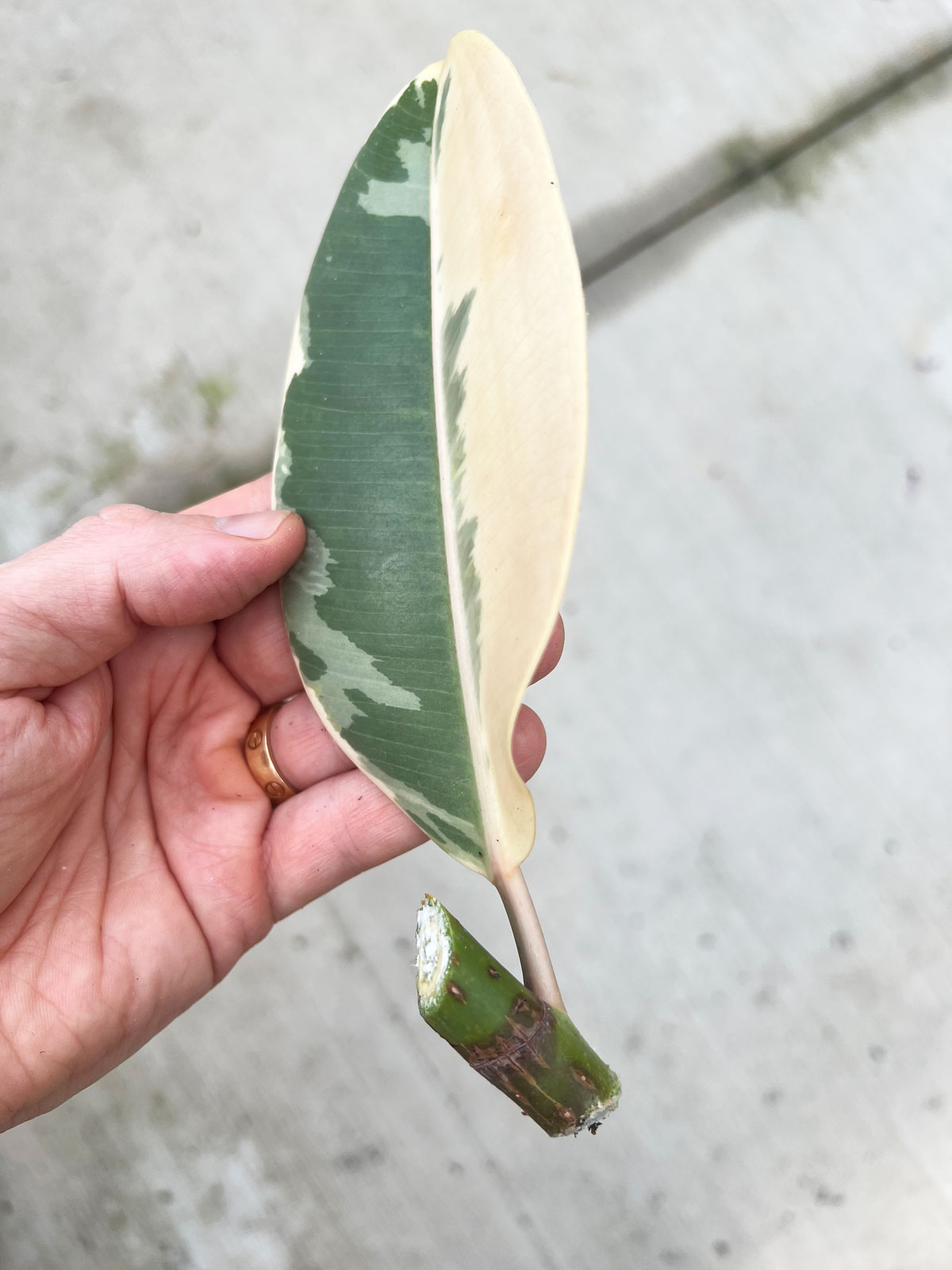Some of the links in this post may be affiliate links.
The Rubber Plant, or Ficus elastica, has been a staple in many houseplant collections due to its ease of care, availability, and variety of beautiful cultivars that are now on the market. Gone are the days of just plain green rubber plants. There are now many stunning cultivars available, including a few striking variegated varieties. Keep reading to discover 11 beautiful rubber plant varieties that you can add to your houseplant collection.

The native range of Ficus elastica is Nepal to China and Malaysia, though it has become naturalized around the world in many subtropical to tropical locations.
In my many travels around the world, I’ve witnessed these plants naturalized in many areas including California, and throughout Mexico, Europe, and more.
Table of Contents
11 Popular Rubber Plant Varieties
I’ve separated this post into two sections for Ficus elastica types.
The first section is on variegated rubber plant varieties, and the second section is for green rubber plant varieties.
Keep in mind that often times, multiple names are used for the same rubber plant variety. This proliferation of names can make it confusing to determine what type of rubber plant you have, but I’ve tried to condense this post down to unique varieties, and have mentioned any equivalent names where they apply.
VARIEGATED RUBBER PLANT VARIETIES WITH PICTURES
1. Ficus elastica ‘Tineke’

Ficus elastica ‘Tineke’ is undoubtedly one of the best-looking rubber plant varieties to add to your houseplant collection.
Its distinctive variegated foliage comes in varied shades of green and cream, and even some pink in the younger leaves.
The ‘Tineke’ cultivar is often advertised simply as “variegated rubber tree.”
To add to its beauty, the sheaths are a lovely pink color.
Keep in mind that any variegated rubber plant needs sufficient light in order to keep its level of variegation. Lighting that is too dim will cause the plant to reduce its levels of variegation.
2. Ficus elastica ‘Doescherii’
Ficus elastica ‘Doescherii’ is another variegated variety of rubber plant which is grown for its decorative foliage.
The foliage is narrower than most rubber plant types, and feature eye-catching patterns of green, yellow, white and grey. To add to the interest, it has pink midribs.
3. Ficus elastica ‘Ruby’
Ficus elastica ‘Ruby’ is a mesmerizing cultivar of the Ficus elastica. The leaves feature vibrant reddish-pink tones with shades of cream and green. As they mature, the redness mellows to dark green and cream with hints of pink.
Differences between ‘Tineke’ and ‘Ruby’:
- Both will have new leaves that are pretty pink. However, ‘Tineke’ foliage will lose any pink coloration as it matures and generally only keeps its green and cream colors. ‘Ruby’ on the other hand, will keep its pinkish red color even on mature leaves.
- Another notable difference is the color of the sheaths. ‘Tineke’ features greenish sheaths with a faint pink color. The ‘Ruby’ sheaths are a bold shade of pink.
- ‘Ruby’ also tends to be more expensive than the more common ‘Tineke’.
4. Ficus elastica ‘Belize’ or ‘Red Ruby’
Ficus elastica ‘Belize’ (sometimes known as ‘Red Ruby’) has dazzling oval, leathery leaves which have striking variegation in shades of green, cream and pink.
Immature leaves have more pronounced reddish-pink hues which mellow down to green and cream as they mature.
VARIEGATED RUBBER PLANT TIPS
These tips will apply specifically to variegated rubber plants like ‘Tineke’, ‘Doescherii’, ‘Ruby’, ‘Belize’ and any other variegated rubber plants.
- More light is needed for variegated types vs. non-variegated types. Failing to do so will cause fading of vivid color in the foliage and reduced growth rate. Aim for at least a few hours of direct sun for your variegated rubber plants (non-variegated plants will benefit as well!)
- Take special care in acclimating your variegated rubber plant to higher light. Don’t do it too suddenly otherwise your plant can burn. Gradually increase any direct sun exposure slowly until your plant is fully acclimated. Don’t let anyone tell you that variegated rubber plants can’t take a lot of direct sun. They can! They just have to be acclimated slowly enough so no damage occurs to the foliage (particularly when moving your plant outdoors, or even if your plant has been in a dim location and you situate it suddenly to a very sunny window indoors).
GREEN RUBBER PLANT VARIETIES WITH PICTURES
Although the variegated rubber plant types more visually striking, the plain green varieties make for wonderful houseplant and can be less finicky to grow.
5. Ficus elastica

Ficus elastica is the plain old species of rubber plant and has been a standard classic houseplant due to its ease of care and beautiful, large, leathery leaves.
Also called the Rubber Fig or the Indian Rubber bush, F. elastica can grow to massive heights of up to 100 feet in its natural habitat.
It was extensively grown indoors in the early 1950s, but has since been replaced by the numerous, beautiful cultivars found in the rest of this post.
F. elastica has beautiful emerald green leaves and scarlet red sheaths from which new leaves emerge.
Contrary to what many people think, the plant is a sun lover and grows best in spots which receive plenty of direct sun, but will still grow even in no direct sun indoors, provided that it is not far from a window.
6. Ficus elastica ‘Decora’
Ficus elastica ‘Decora’ is a gorgeous rubber plant variety which gets the name from its decorative foliage. The nearly 12 inch long leaves can fill in any room with rich shades of emerald green and pops of red from the sheaths.
‘Decora’ was a new cultivar of rubber plant around 1950 or so and has a more attractive growth habit than the plain Ficus elastica species.
It also has broader leaves compared to the plain species, and the leaves are glossier.
Newer leaves are a gorgeous bronze color, and then mature to a gorgeous emerald green color.
7. Ficus elastica ‘Burgundy’

Ficus elastica ‘Burgundy’ is an exotic-looking variety of rubber plant which is also known as Ficus elastica ‘Abidjan’ and Ficus elastica ‘Black Prince’.
The leaves will start off as a deep crimson color, and then darken to a green so rich that it appears black.
The sheaths are a stunning, rich red.
8. Ficus elastica ‘Robusta’

Ficus elastica ‘Robusta’ is a more compact form of rubber tree.
It resembles the ‘Decora’ cultivar, but has the added benefits of having a more compact growth habit and a more freely branching nature.
9. Ficus elastica ‘Melany’
Ficus elastica ‘Melany’ is a compact growing variety of the Ficus elastica. The plant has narrow and smaller leaves than other rubber plant varieties.
The pinkish sheaths protect the new leaves.
10. Ficus elastica ‘Chloe’
Ficus elastic ‘Chloe’ features shiny, huge olive green leaves that have beautifully contrasting pink sheaths on emerging leaves.
11. Ficus elastica ‘Sophia’
Ficus elastica ‘Sophia’ is a compact variety of rubber plant.
It is similar to the ‘Robusta’ cultivar except with smaller and rounder leaves.
RELATED RESOURCES
If you’re looking for an amazing potting mix that you can use straight out of the bag for your Ficus, check out the Rainforest Soil Blend from Oh Happy Plants. This is an amazing mix and you will get 10% off at checkout automatically if you use my link.
For specific details on care of rubber plants, as well as a discussion of all the most common problems (and solutions) that people experience with these plants, don’t miss my rubber plant care post. You won’t be disappointed.
Wishing your rubber plant was bushier, check out my blog post on how to make a rubber plant bushy. It’s easier than you think!
And here are the best potting mixes to use for rubber plant.
Lastly, here is how to propagate rubber plants in water.
I hope you’ve enjoyed this post on rubber plant varieties. Do you have any rubber plants? Which ones? Comment below. I’d love to hear!







Events Wadkins
Sunday 1st of December 2024
Sorry, shivereana is the correct spelling.
Events Wadkins
Sunday 1st of December 2024
There is another variety of rubber tree that has been making its rounds in the big box stores. It is a ficus shiver sana AKA moonshine. The leaves are variegated ranging from dark green to light green with reddish copper to green freckling.
Raffaele Di Lallo
Monday 2nd of December 2024
Ah, I wasn't aware of this one! Thanks for commenting!